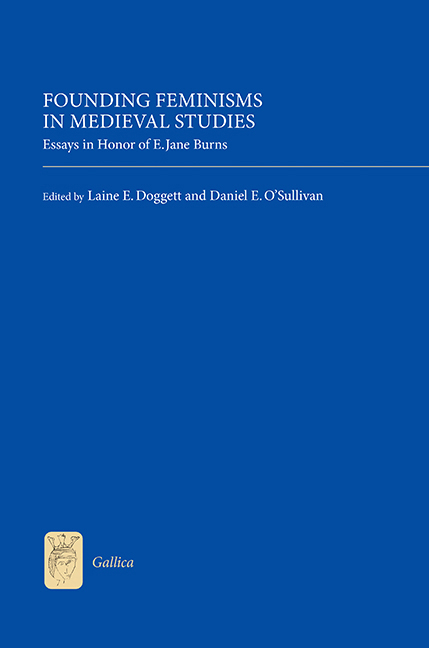Book contents
- Frontmatter
- Contents
- List of Illustrations
- List of Contributors
- Acknowledgements
- Introduction: The Work of E. Jane Burns and the Feminisms of Medieval Studies
- E. Jane Burns: A Bibliography
- Part I Debating Gender
- Part II Sartorial Bodies
- Part III Mapping Margins
- Part IV Female Authority: Networks and Influence
- Afterword: A Response to the Volume
- Feminism and Medieval Studies: Where Have We Been, Where Are We Now, and Where Are We Going? Or, What Has Happened to Women in Feminist Studies of the Middle Ages?
- Index
- Tabula Gratulatoria
- Already Published
Feminism and Medieval Studies: Where Have We Been, Where Are We Now, and Where Are We Going? Or, What Has Happened to Women in Feminist Studies of the Middle Ages?
from Afterword: A Response to the Volume
Published online by Cambridge University Press: 05 July 2016
- Frontmatter
- Contents
- List of Illustrations
- List of Contributors
- Acknowledgements
- Introduction: The Work of E. Jane Burns and the Feminisms of Medieval Studies
- E. Jane Burns: A Bibliography
- Part I Debating Gender
- Part II Sartorial Bodies
- Part III Mapping Margins
- Part IV Female Authority: Networks and Influence
- Afterword: A Response to the Volume
- Feminism and Medieval Studies: Where Have We Been, Where Are We Now, and Where Are We Going? Or, What Has Happened to Women in Feminist Studies of the Middle Ages?
- Index
- Tabula Gratulatoria
- Already Published
Summary
On January 28, 2015, I attended a lecture on Sufi mysticism given by Dr. Lloyd Ridgeon of Theology and Religious Studies at the University of Glasgow. Dr. Ridgeon began his lecture by describing an earlier lecture in which he had spoken about masculinity (javanmardi) in Sufi sources – a topic consistent with recent studies in masculinities – to a room that consisted primarily of Muslim women. The eagerness of that female audience to learn about the history of Islamic women prompted Dr. Ridgeon to ask: “Where are the women in Sufi mysticism?” Noting Islamic female mystics had “fallen through the manhole” of the road to knowledge of historical Islamic mysticism, he decided to explore the topic. His research led him first to the tenth-century biographies of Abd al-Rahman Sulami, whose book The Generation of Sufis discusses in some detail over a hundred male Sufis. Sulami wrote a second, much shorter, book, Worshipping Sufi Women, which provides a list of 82 women in very short entries. Subsequent biographers, such as Ibn Jawzi, included women in their collection of biographies, but many were without names. The search for Sufi women mystics and their work is complicated by the fact that gender distinctions in pronouns are not always clear in Persian. Attar, who wrote a book of Sufi biographies, including an entry on a female Sufi called Rabi'a, wrote, “When a woman is on the path of the lord most high, she cannot be called Woman,” a phrase familiar to those who study female mysticism in Europe from Jerome's Commentary on Ephesians, III ch. 5, “As long as a woman is for birth and children she is different from man as body is from soul. But when she wishes to serve Christ more than the world, then she will cease to be a woman, and will be called man.” Dr. Ridgeon warned that, while the presence of so many women Sufi mystics seems radical, the accounts of these women – Aymana al-din Kirmani, for example – seem to reiterate the conservative complementarity and segregation of men and women that operated in most other Islamic spheres. Nonetheless, accounts of Sufi female mystics echo features that occur in writings of Julian of Norwich or Hildegard of Bingen in which God is cast as female or attributes associated with women, such as abjection and humility, shape what can be called a feminine mystical experience.
- Type
- Chapter
- Information
- Founding Feminisms in Medieval StudiesEssays in Honor of E. Jane Burns, pp. 237 - 246Publisher: Boydell & BrewerPrint publication year: 2016

